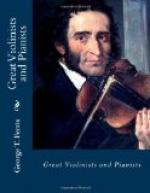III.
During Thalberg’s first visit to America he had an active and dangerous rival in the young and brilliant pianist, Louis Moreau Gottschalk, who was as fresh to New York audiences as Thalberg himself, though the latter had the advantage over his young competitor in a fame which was almost world-wide. Of American pianists Louis Gottschalk stands confessedly at the head by virtue of remarkable native gifts, which, had they been assisted by greater industry and ambition, might easily have won him a very eminent rank in Europe as well as in his own country. An easy, pleasure-loving, tropical nature, flexible, facile, and disposed to sacrifice the future to the present, was the only obstacle to the attainment to a place level with the foremost artists of his age.
Edward Gottschalk, who came to America in his young manhood and settled in New Orleans, and his wife, a French Creole lady, had five children, of whom the future pianist was the eldest, born in 1829. His feeling for music manifested itself when he was three years old by his ability to play a melody on the piano which he had heard. Instantly he was strong enough, he was placed under the instruction of a good teacher, and no pains were spared to develop his precocious talent. At the age of six he had made such progress on the piano that he was also instructed on the violin, and soon was able to play pieces of more than ordinary difficulty with taste and expression. We are told that the lad gave a benefit concert at the age of eight to assist an unfortunate violin-player, with considerable success, and was soon in great request at evening parties as a child phenomenon. The propriety of sending the little Louis to Paris had long been discussed, and it was finally accomplished in 1842.
On reaching Paris he was first put under the teaching of Charles Halle, but, as the latter master was a little careless, he was replaced by M. Camille Stamaty, who had the reputation of being the ablest professor in the city. The following year he began the study of harmony and counterpoint with M. Malidan, and the rapid progress he evinced in his studies was of a kind to justify his parents in their wish to devote him to the career of a pianist.




